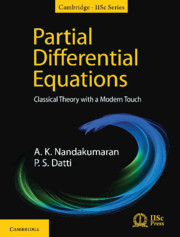Book contents
- Frontmatter
- Dedication
- Contents
- List of Illustrations
- Preface
- Acknowledgments
- Notations
- Chapter 1 Introduction
- Chapter 2 Preliminaries
- Chapter 3 First-Order Partial Differential Equations: Method of Characteristics
- Chapter 4 Hamilton–Jacobi Equation
- Chapter 5 Conservation Laws
- Chapter 6 Classification of Second-Order Equations
- Chapter 7 Laplace and Poisson Equations
- Chapter 8 Heat Equation
- Chapter 9 One-Dimensional Wave Equation
- Chapter 10 Wave Equation in Higher Dimensions
- Chapter 11 Cauchy–Kovalevsky Theorem and Its Generalization
- Chapter 12 A Peep into Weak Derivatives, Sobolev Spaces and Weak Formulation
- References
- Index
Preface
Published online by Cambridge University Press: 20 May 2020
- Frontmatter
- Dedication
- Contents
- List of Illustrations
- Preface
- Acknowledgments
- Notations
- Chapter 1 Introduction
- Chapter 2 Preliminaries
- Chapter 3 First-Order Partial Differential Equations: Method of Characteristics
- Chapter 4 Hamilton–Jacobi Equation
- Chapter 5 Conservation Laws
- Chapter 6 Classification of Second-Order Equations
- Chapter 7 Laplace and Poisson Equations
- Chapter 8 Heat Equation
- Chapter 9 One-Dimensional Wave Equation
- Chapter 10 Wave Equation in Higher Dimensions
- Chapter 11 Cauchy–Kovalevsky Theorem and Its Generalization
- Chapter 12 A Peep into Weak Derivatives, Sobolev Spaces and Weak Formulation
- References
- Index
Summary
We ventured into writing this book Partial DifferentialEquations knowing very well that writing a textbook on a veryold discipline, that too for beginners, is indeed a formidable task. Thisexercise was partly due to the good response we received for our first book,Ordinary Differential Equations, co-authored with RajuK. George, whose contents were also classical. The venture was also partlydue to the suggestions we have received during our interactions withstudents and teachers from various institutions in the country. The choiceof the contents for this book are largely based on such interactions andalso on our training in the subject. It is our wish that such a course onpartial differential equations (PDE) should seriously be taught at seniorundergraduate or beginning graduate level at various institutions in thecountry, so as to prepare a student for a more serious study of the advancedtopics.
This book should be accessible to anyone with sound knowledge in severalvariable calculus, save for a couple of chapters where the reader isexpected to have knowledge of the modern integration theory. The bookessentially deals with first-order equations, the classical Laplace andPoisson equations, heat or diffusion equation and the wave equation. Thefull generality was never on our minds. Numerical analysis and computationsare not considered here. Nevertheless, students and researchers working onthese aspects of the subject can also gain something from the book. Almostall the topics considered here, of course, arise from the realworldapplications in physics, engineering, biology, and so on. Though there is nodiscussion on the applications in the book, the community of students andresearchers from these applied fields can also benefit from the book. Wehave also presented a detailed description of the classification of PDE,including a motivation behind classification.
A few words about the title. The subject of PDE has undergone great changeduring the last 70 years or so after the development of modern functionalanalysis, in particular distribution theory andSobolev spaces. In the modern concept, the PDE isvisualized in a more general setup of functional analysis, where we look forsolutions in a sense weaker than the usual classical senseto address the more physically relevant solutions.
- Type
- Chapter
- Information
- Partial Differential EquationsClassical Theory with a Modern Touch, pp. xiii - xivPublisher: Cambridge University PressPrint publication year: 2020

